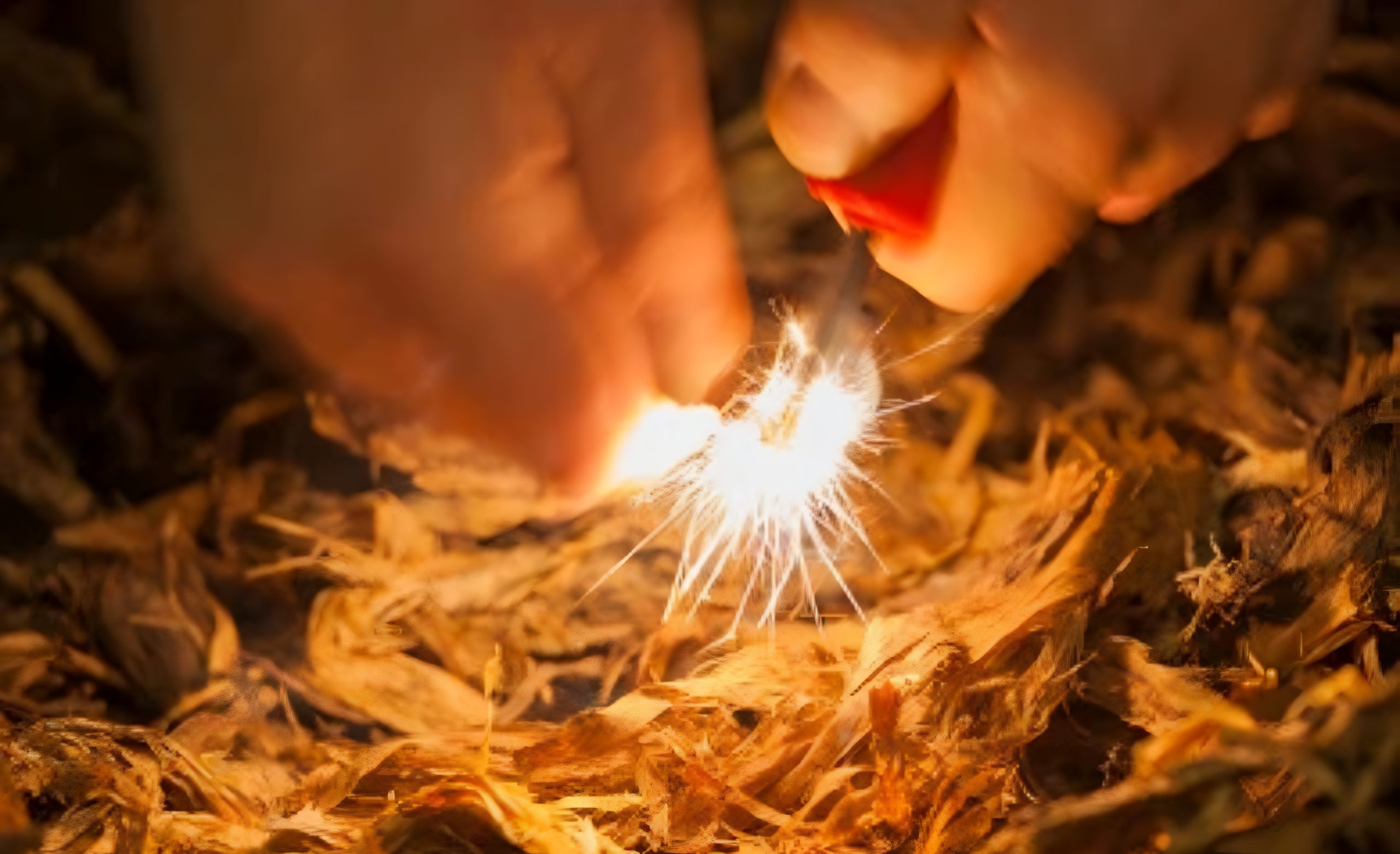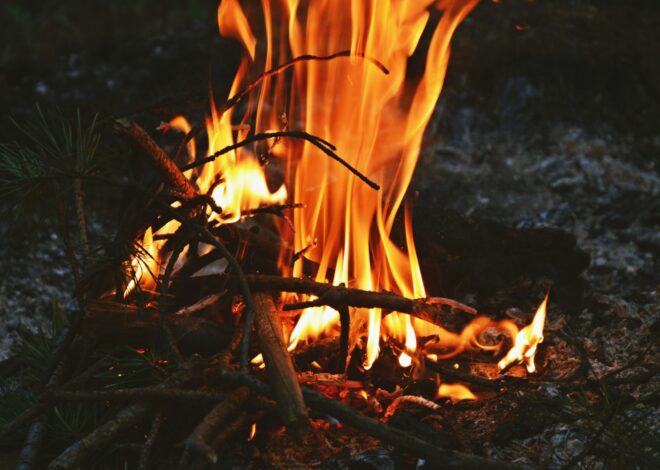
Starting A Fire With Flint & Steel
Starting a fire with flint and steel is an ancient skill that sparks both curiosity and adventure. Imagine standing in the great outdoors, surrounded by nature’s beauty, and harnessing one of humanity’s oldest techniques to create warmth and light. This method connects us to our ancestors who relied on it for survival.
It blends practicality with a sense of accomplishment. In today’s tech-driven world, rediscovering this traditional technique can be empowering. Whether you’re prepping for your next camping trip or simply looking to hone your outdoor skills, mastering the art of starting a fire with flint and steel opens doors to self-sufficiency.
Get ready to learn how this simple yet effective tool can ignite more than just flames—it can spark a newfound passion for wilderness living!
History of Flint & Steel as a Fire Starter
Flint and steel have ignited human innovation for centuries. This ancient technique dates back to prehistoric times when early humans discovered that striking flint against iron could produce sparks. In the Middle Ages, it became a vital method for starting fires.
People relied on this combination during harsh winters and in survival situations. The technology evolved over time. By the 17th century, flintlock firearms emerged, utilizing similar principles of spark generation. This made flint even more integral to daily life.
Before matches were invented in the 19th century, every household kept a piece of steel handy alongside their flint stones. It was a reliable way to maintain warmth and cook food. Today, it remains popular among outdoor enthusiasts and survivalists who appreciate its historical significance and reliability as a fire-starting tool.
Benefits of Using Flint & Steel
Using flint and steel to start a fire comes with numerous advantages. For starters, it’s a reliable method that has stood the test of time. Unlike modern conveniences, it doesn’t rely on batteries or matches. Another benefit is the skill involved. Mastering this technique enhances your survival skills and fosters a deeper connection with nature.
The process requires focus, patience, and an understanding of materials. Flint and steel also provide versatility in different environments. They work well in various weather conditions, making them ideal for outdoor adventures. This method encourages resourcefulness as you learn to identify suitable tinder and kindling around you.
Additionally, using flint and steel can be more environmentally friendly compared to disposable lighters or matches. It promotes sustainability by encouraging users to embrace natural resources responsibly while minimizing waste from single-use products.
Choosing the Right Materials:
Choosing the right materials is crucial for successful fire starting with flint and steel. Taking the time to select proper materials will enhance your chances of successfully starting a fire while honing valuable survival skills.
– Flint
Flint is a sedimentary rock that has been used for centuries as a fire-starting tool. Its hardness enables it to create sparks when struck against steel, making it an essential part of traditional fire-making techniques.
When selecting flint, look for stones with sharp edges and smooth surfaces. These features enhance the ability to generate sparks effectively.
Natural deposits can often be found in riverbeds or on rocky slopes. Alternatively, you can purchase quality flint pieces from outdoor supply stores.
Remember that not all rocks are created equal; some may produce better results than others. Experimenting with different types will help you find the best fit for your needs in starting a fire with flint and steel.
– Steel
Steel is a critical component in fire-starting with flint. Its hardness and ability to create sparks make it an ideal choice for this ancient method. Not all steel will work effectively, though.
Look for high-carbon steel, as it generates the best sparks when struck against flint. The key factor here is that the edge must be sharp enough to produce friction but not so fine that it becomes brittle.
Some enthusiasts prefer using specific tools designed for striking, such as striker bars or even old carbon steel files. These can provide reliable performance while ensuring durability during use.
Choosing the right shape also plays a role; flat edges tend to yield better results than rounded ones. This allows you to maximize the potential of each strike, increasing your chances of catching those elusive sparks quickly and efficiently.
Steps to Start a Fire with Flint & Steel:
It’s all about patience and technique here!
#1. Gathering the Necessary Materials
To start a fire with flint and steel, you first need to gather the right materials. This is crucial for success.
Begin by selecting your flint. Look for a hard rock that can produce sharp edges. Quartz or chert works well and is often found in riverbeds or rocky areas.
Next, choose your steel. A carbon steel striker is ideal as it creates sparks when struck against flint. You might even repurpose an old file or saw blade if you’re feeling creative.
Don’t forget about tinder! Natural options include dry grass, leaves, or birch bark—anything that ignites easily should work perfectly.
Consider some kindling like small twigs to help transition from tinder to larger logs once the fire starts catching on. Gather these items before heading out; preparation paves the way for success in your fire-starting adventure!
#2. Preparing the Flint and Steel
To prepare your flint and steel, start by selecting high-quality materials. The flint should have a sharp edge; this is crucial for creating sparks. Look for a piece that’s not too smooth but has some roughness to it.
Next, choose your steel carefully. High-carbon steel works best as it produces brighter sparks. Ensure it’s clean and free from rust or debris, which can hinder its effectiveness.
Hold the flint steady in one hand while gripping the steel in the other. Angle them correctly for optimal spark generation—about 30 degrees usually does the trick.
Before striking, position your tinder bundle nearby so you can quickly transfer any sparks created into it. This preparation enhances your chances of success when you make that first strike!
#3. Building a Proper Tinder Bundle
To successfully start a fire with flint and steel, crafting the right tinder bundle is key. A well-built tinder bundle acts as an ignition point, catching sparks quickly and sustaining initial flames.
Begin by gathering fine materials such as dry grass, leaves, or tree bark. These natural elements ignite easily and will help you transition from spark to flame. Avoid damp materials; moisture can hinder your efforts significantly.
Once you have your chosen materials, create a nest-like structure. Loosely twist or arrange them in a way that allows air to circulate freely. The more oxygen present, the better your chances of maintaining a robust flame.
Incorporate smaller twigs or sticks into the mix for added support once your tinder catches fire. This layered approach ensures that when the sparks land on your bundle, it has everything needed to grow into a lively blaze.
#4. Striking the Flint and Steel
To strike the flint and steel effectively, hold the flint securely in one hand. Position it so that its sharp edge faces down toward your tinder bundle.
With your other hand, grip the steel at a comfortable angle. Aim to create a spark rather than just a glancing blow. A firm, quick motion works best—think of it as snapping your wrist while bringing the steel against the flint.
As you strike, watch for sparks flying towards your prepared tinder. Timing is crucial; you want these sparks to land on dry materials that can catch fire easily.
If nothing ignites on the first try, don’t be discouraged. Adjust your technique or change angles slightly for better results. Perseverance pays off when mastering this ancient skill!
#5. Maintaining the Fire
Maintaining a fire is an art that requires attention and care. Once you’ve successfully ignited the flames, your job isn’t over. You must monitor it closely to ensure it burns steadily.
Start by adding small sticks or twigs regularly. This keeps the fire fueled without overwhelming it with large logs too soon. Watch how the flame behaves; a roaring blaze can quickly turn into embers if neglected.
Adjusting airflow is also vital. If you’re using a fireplace or fire pit, make sure there’s enough space for air to circulate around the burning material. Oxygen fuels fire, so don’t smother your flames.
Keep nearby tinder handy as well, in case you need to reignite parts of your bundle or boost dwindling flames back to life.
Enjoy the warmth and glow while being mindful of safety practices around open flames!
Tips for Successful Fire Starting with Flint & Steel
Practice makes perfect. Spend time familiarizing yourself with the flint and steel technique before relying on it in a survival situation. Choose dry materials for your tinder bundle. Natural fibers like dried grass, bark, or leaves ignite faster and help catch sparks more effectively.
Angle your strike correctly. This helps create maximum friction and generates hotter sparks that can easily ignite your tinder. Keep moving air around the fire as soon as you have an ember. A gentle breath or fan motion encourages flames to grow stronger and spread to larger kindling.
Don’t rush the process; patience is vital when starting a fire this way. Allow each step its due diligence for better results. Experiment with different types of steel and flint combinations to find what works best for you under various conditions.
Safety Precautions while Using Flint & Steel
Using flint and steel can be a thrilling way to start a fire, but safety should always come first. It’s essential to work in an open space away from flammable materials. Dry leaves, twigs, or grass nearby can quickly turn a small spark into a raging inferno.
Always wear protective eyewear when striking the flint against the steel. Small shards of rock can fly off unpredictably and cause eye injuries. Gloves are also recommended; they provide grip and prevent accidental cuts while handling sharp tools.
Keep water or sand close by as an emergency extinguishing method. This ensures you’re prepared if things get out of hand unexpectedly. Practice your techniques before heading out into nature for real-world applications. The more familiar you become with your gear and methods, the safer you’ll be when it counts most.
Alternative Fire Starting Methods
When it comes to starting a fire, flint and steel aren’t your only options. There are several alternative methods worth exploring. One popular choice is using a lighter or matches. These tools provide an easy ignition source for kindling and tinder without the need for technique or skill.
Another approach is the bow drill method. This ancient technique harnesses friction between wood pieces to create an ember, requiring patience and practice but offering a rewarding experience. For those who prefer modern solutions, magnesium fire starters are compact and effective. Scraping off magnesium shavings creates sparks that ignite easily when combined with dry materials.
You can experiment with chemical reactions like potassium permanganate mixed with glycerin. This combination produces intense heat quickly but requires careful handling due to its reactive nature. Exploring these alternatives opens up endless possibilities for your next outdoor adventure!
Conclusion: Learning How to Start a Fire with Flint & Steel
Learning to start a fire with flint and steel is not just about survival; it’s an ancient skill that connects us to our ancestors. Mastering this technique can be both rewarding and empowering. It allows you to appreciate the beauty of nature while developing self-reliance.
As you embark on your journey, remember that practice makes perfect. The more you experiment with different materials and techniques, the better you’ll become at igniting flames. This traditional method offers a unique experience compared to modern conveniences, making each successful spark feel like an accomplishment.
Embrace the challenge of starting a fire with flint and steel. Whether you’re camping in the wilderness or simply enjoying a backyard bonfire, this timeless skill brings warmth and light into your life—literally and figuratively!



